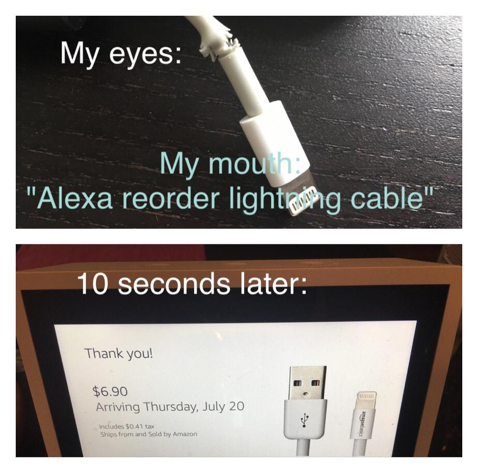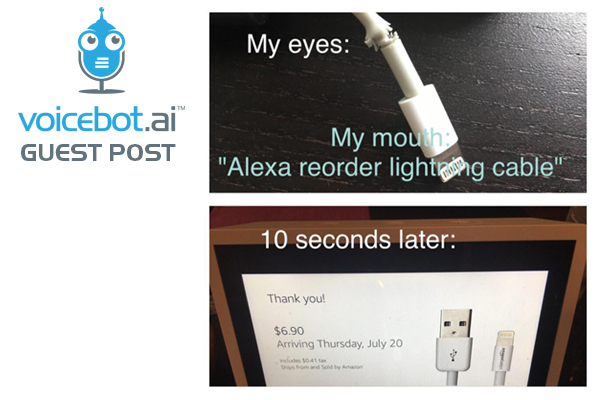When Voice Meets Impulse Buy: From Thought to Transaction in 22.6 seconds
‘tis the season. The season of flies in our kitchen. In the past, my wife and I have used anything we could find to eliminate the annoyance. While my wife usually tries to find a way to save the fly’s life, I am usually less merciful. Today, I had enough.
We have an Echo Show in our kitchen. It didn’t take much to put 1 and 1 together. Here’s a rough outline of what happened next:
| Time in seconds it took to… | ~ |
| Decide I wanted to buy a fly swat once and for all: | 3.2 seconds |
| Say “Alexa, buy me a fly swat”: | 2.7 seconds |
| Alexa to respond with a listing of 5 fly swats to choose from: | 4.9 seconds |
| Swipe to the right to settle on option 3 based on ratings and price: | 7.2 seconds |
| Tap option 3 to make purchase: | 0.5 seconds |
| Alexa to confirm the purchase: | 4.1 seconds |
22.6 seconds from thought to completed transaction. Is that a new world record? I don’t know, is anyone tracking this yet? TTT – Thought-To-Transaction. Did I just come up with a new marketing metric??
Zero Friction Impulse Buying from Home
 I could give another example, as the fly swat was not my first impulse buy on the Echo Show. The other day I realized that one of my charging cables used in my home office had worn out. I ordered a replacement cable in a similar amount of time.
I could give another example, as the fly swat was not my first impulse buy on the Echo Show. The other day I realized that one of my charging cables used in my home office had worn out. I ordered a replacement cable in a similar amount of time.
Short of a brain API that knows what I want before I say a thing, voice today is the most suitable channel to reduce TTT time for commodities. Think about it. Amazon has a track record of simplifying the process of converting buying intents into buying decisions into buying actions. And they are on their way to becoming the first 1 trillion-dollar company planet Earth has seen.
Amazon is Not Alone
Other companies have successfully copied that approach. Domino’s launched their “Anyware” concept back in 2015. It is constantly evolving, now featuring 10 distinct digital ways of ordering a pizza, with Google Home being the most recent addition, each removing more and more friction from the customer experience, each further reducing TTT time. And, their mobile app and website (launched in 2007) aren’t even included! Where other companies are still stuck in the 2007 way of doing “digital,” companies like Domino’s are showing us how to do it right. We should all be thankful! Someone’s paving the way for the late adopters and laggards.
Brian Roemmele was recently quoted on Forbes with the following analysis:
- Average Amazon Prime user spends ~$1500 per year
- Echo users increase sales at Amazon by ~$150 per year
- There are ~ 10 million Alexa enabled devices in early 2017
- If half (5 million) Alexa enabled device owners spend ~$150 more per year, Amazon experiences ~$750,000,000 new revenue
These are staggering numbers. And, they aren’t just great for Amazon. They are great for the entire ecommerce industry.
Changing Consumer Habits
The biggest hurdle to adoption for this form of buying will be to change habits and behavior of the consumer. The fact that I used Alexa to order commodities is based on the fact that I’m a techie, an early adopter, and a voice enthusiast. Subtract all 3 and you arrive at the average user. But what remains? What remains is the desire within all of us to simplify our lives. Our desire to prefer simple over complicated; it’s in our DNA.
So, while it might take time for even the current owners of Echo, Echo Dot, Echo Tap, Echo Look, or Echo Show to change their behavior and think of Echo first when needing to purchase something, it will likely happen. For those hesitant to buy into the voice and messaging craze at all, let’s revisit some technology history:
- When color TV came out, black & white TV owners probably asked, “So, you want me to dump my expensive TV set and buy something that tells me the same stories or broadcasts the same news, just with some added color?” – Guess what? They did.
- When the CD came out, record owners probably asked, “So, you want me to buy a new player and all the same music again, just for a little bit more convenience of direct access to tracks and higher quality?” Guess what? They did.
- When the DVD came out, VHS owners probably asked, “So, you want me to buy a new player and all the same movies again, just for a little bit more convenience of direct access to scenes and higher quality?” Guess what? They did.
- When the laptop came out, PC owners probably asked, “So you want me to buy a new machine which can do exactly the same as my PC at home, just for a little bit more convenience of portability?” Guess what? They did.
- When the cell phone came out, landline telephone owners probably asked, “So, you want me to buy a new device with which I can do exactly the same as my telephone at home, just for a little bit more convenience of portability?” Guess what? They did.
- When the smartphone came out, cell phone owners probably asked, “So, you want me to buy a new device with which I can do exactly the same as my cell phone and my portable laptop, just for a little bit more convenience of quicker access to the Internet?” Guess what? They did.
- When the tablet came out, smartphone owners probably asked, “So, you want me to buy a new device with which I can do exactly the same as my smartphone and my portable laptop, just for a little bit more convenience of use?” Guess what? They did.
I believe that in (consumer) technology, it is all about the following areas of impact:
- Convenience
- User Experience (UX)
- Communication
- Information Accessibility
If some of these come together in a new product or user interface (UI), we will likely see its success. And, never forget Amara’s Law:
We tend to overestimate the effect of a technology in the short run and underestimate the effect in the long run.
About the Author
Tobias Goebel is Director of Emerging Technologies at Aspect and has worked with voice technology for nearly twenty years. He has 15 years of experience in customer care technology and the contact center industry with roles spanning engineering, consulting, pre-sales engineering, program and product management, and product marketing. As part of Aspect’s product management and marketing team today, he works on defining the future of the mobile customer experience, bringing together channels such as mobile apps, messaging, voice, and social. He is a frequent speaker and blogger on topics around customer service and, more recently, the (re-)emerging chatbot, NLP, and AI technologies. Tobias holds degrees in Computational Linguistics, Phonetics, and Computer Science from the universities of Bonn, Germany and Edinburgh, UK.









